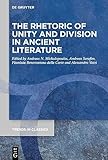The Rhetoric of Unity and Division in Ancient Literature / ed. by Andreas N. Michalopoulos, Andreas Serafim, Flaminia Beneventano della Corte, Alessandro Vatri.
Material type: TextSeries: Trends in Classics - Supplementary Volumes ; 108Publisher: Berlin ; Boston : De Gruyter, [2021]Copyright date: ©2021Description: 1 online resource (XI, 450 p.)Content type:
TextSeries: Trends in Classics - Supplementary Volumes ; 108Publisher: Berlin ; Boston : De Gruyter, [2021]Copyright date: ©2021Description: 1 online resource (XI, 450 p.)Content type: - 9783110609790
- 9783110609868
- 9783110611168
- online - DeGruyter
- Issued also in print.
| Item type | Current library | Call number | URL | Status | Notes | Barcode | |
|---|---|---|---|---|---|---|---|
 eBook
eBook
|
Biblioteca "Angelicum" Pont. Univ. S.Tommaso d'Aquino Nuvola online | online - DeGruyter (Browse shelf(Opens below)) | Online access | Not for loan (Accesso limitato) | Accesso per gli utenti autorizzati / Access for authorized users | (dgr)9783110611168 |
Frontmatter -- Contents -- Acknowledgements -- List of Tables -- Unity and Division in Ancient Literature: Current Perspectives and Further Research -- Part I: Authors, Speakers and Audience -- The Rhetoric of (Dis)Unity in the Attic Orators -- Creating a Cultural Community: Aeschines and Demosthenes -- “I, He, We, You, They”: Addresses to the Audience as a Means of Unity/Division in Attic Forensic Oratory -- Rhetoric of Disunity Through Arousal of Hostile Emotions in Eisangelia Cases -- “It Takes More Love to Kill a Son than to Vindicate Him”: How Maxims May Contribute to Affiliation -- Part II: Emotions -- Projective Uses of Emotions, Out-groups and Personal Characterization: The Case of Against Aristogeiton I (Dem. 25) -- Xenophon on Strategies to Maintain Unity in Armies under Stress -- Part III: Drama and Poetry -- Divided Audiences and How to Win Them Over: The Case of Aristophanes’ Acharnians -- Fighting Against an Intruder: A Comparative Reading of the Speeches of Pentheus (3.531–563) and Niobe (6.170–202) in Ovid’s Metamorphoses -- Humorous Unity and Disunity between the Characters in Vergil’s Eclogues 1 and 2 -- Part IV: Historical and Technical Prose -- Disunity and the Macedonians in the Literature of Alexander: Plutarch, Arrian and Curtius Rufus -- Divisive Scholarship: Affiliation Dynamics in Ancient Greek Literary Criticism -- The Rhetoric of Homonoia in Dio Chrysostom’s Civic Orations -- Finding Unity through Knowledge: Narrative and Identity-Building in Greek Technical Prose -- Part V: Gender and the Construction of Identity -- Vanishing Mothers. The (De)construction of Personal Identity in Attic Forensic Speeches -- Cato vs Valerius/Men vs Women: Rhetorical Strategies in The Oppian Law Debate in Livy’s Ab Urbe Condita -- Humanitas: A Double-edged Sword in Apuleius the Orator? -- Part VI: Religious Discourse -- Rhetoric of the Mortals, Rhetoric of the Gods. Deigmata, Phasmata and the Construction of Evidence -- Ciceronian vs Socratic Dialogue in the De divinatione -- Unity and Disunity in Paulinus of Nola Poem 24 -- Note on Editors and Contributors -- General Index -- Index Locorum
restricted access online access with authorization star
http://purl.org/coar/access_right/c_16ec
This volume, comprising 24 essays, aims to contribute to a developing appreciation of the capacity of rhetoric to reinforce affiliation or disaffiliation to groups. To this end, the essays span a variety of ancient literary genres (i.e. oratory, historical and technical prose, drama and poetry) and themes (i.e. audience-speaker, laughter, emotions, language, gender, identity, and religion).
Issued also in print.
Mode of access: Internet via World Wide Web.
In English.
Description based on online resource; title from PDF title page (publisher's Web site, viewed 28. Feb 2023)


